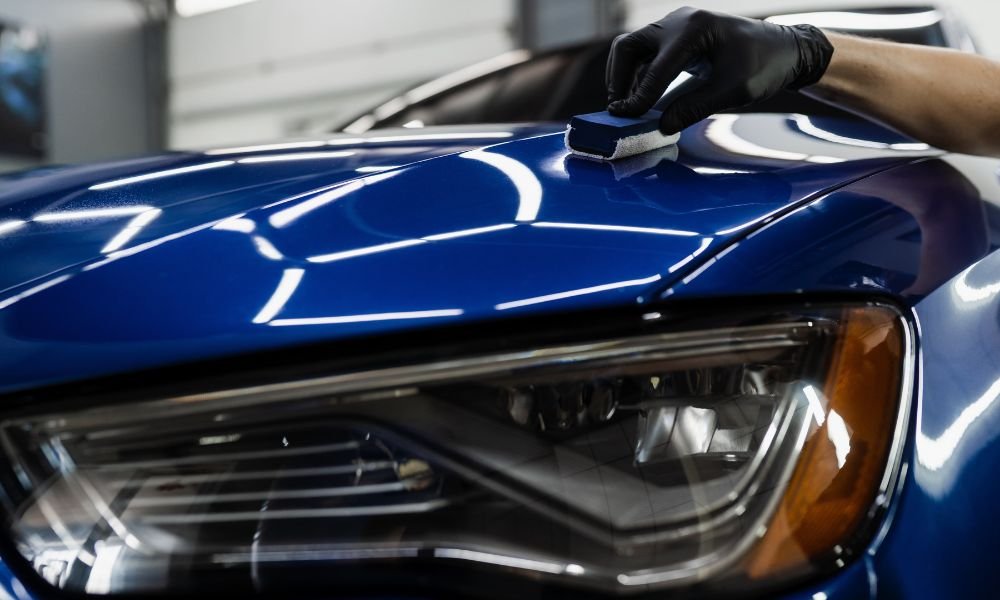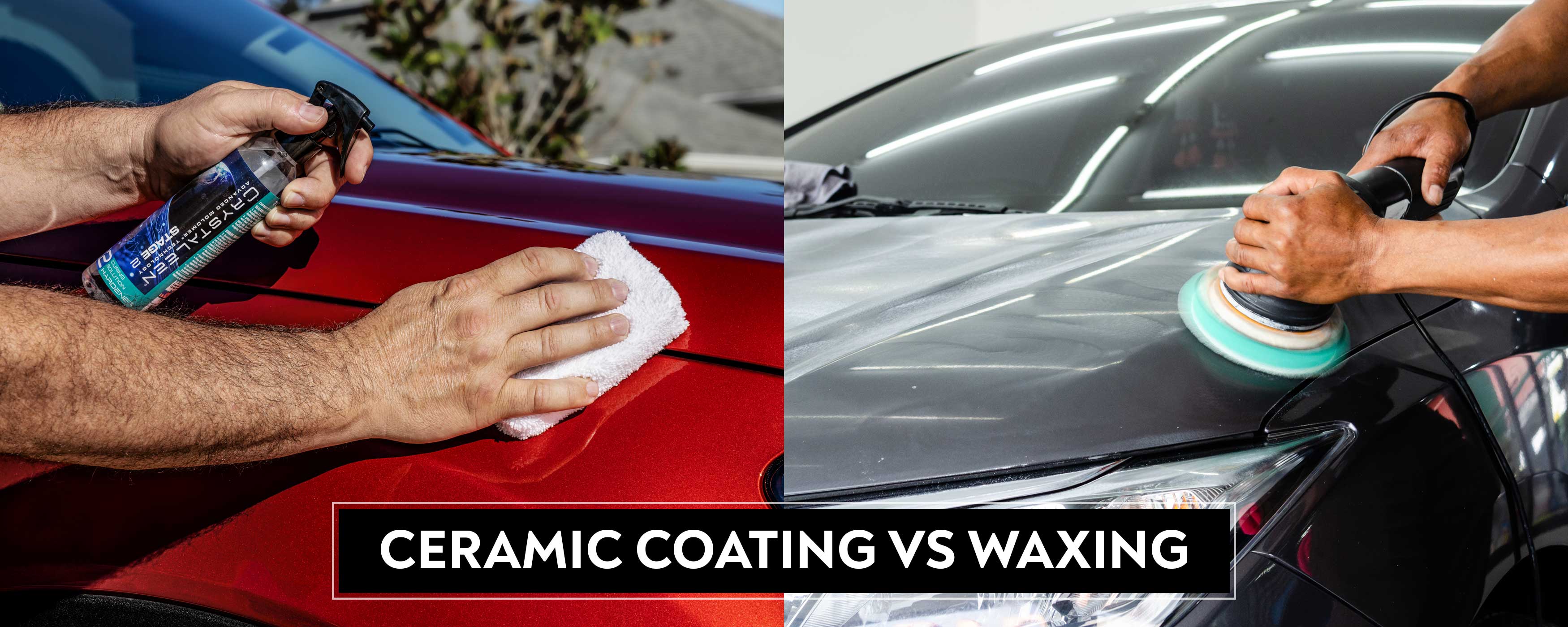Ceramic Coating vs. Traditional Wax: Which One Offers Superior Defense?
Ceramic Coating vs. Traditional Wax: Which One Offers Superior Defense?
Blog Article
Comprehending the Science Behind Ceramic Coating for Improved Automobile Sturdiness
The scientific research of ceramic covering is revolutionizing vehicle maintenance by providing an awesome guard against harsh environmental elements. As we discover the elaborate make-up and application process of ceramic finishes, we uncover the secrets behind their remarkable protection and durability (ceramic coating). How does this compare to standard methods, and what effects does it have for car upkeep in the lengthy term?

Composition of Ceramic Coatings
Ceramic coverings are mainly composed of silicon dioxide (SiO2), which is derived from all-natural materials like quartz and sand. This substance develops the backbone of the finish, giving its particular hardness and resistance to ecological components. Along with SiO2, ceramic layers often integrate titanium dioxide (TiO2) for boosted UV defense and enhanced resistance to toxic wastes. These nanocomposite products create a durable, chemical bond with the automobile's surface area, providing an enduring safety layer.
The solution of ceramic coatings is a precise process where the focus of SiO2 can significantly influence the covering's performance. Higher SiO2 web content normally causes better sturdiness and firmness, contributing to the coating's ability to stand up to scratches and chemical etching. The balance of components is crucial; too much SiO2 can make the layer brittle, while too little can jeopardize its safety properties.
Producers might also incorporate added materials, such as polysilazane, to boost adaptability and convenience of application. These ingredients boost the layer's hydrophobic residential properties, ensuring water and contaminants bead off the surface area effortlessly. This engineered make-up highlights the effectiveness of ceramic coverings in guarding a car's outside versus a variety of damaging conditions.
Application Refine Clarified
Using a ceramic covering to a vehicle involves several critical actions, each necessary to guaranteeing optimum attachment and performance of the safety layer - ceramic coating. The procedure begins with a complete clean and decontamination of the automobile's surface area to eliminate dirt, crud, and previous waxes or sealers. This action is essential as any contaminants left on the surface can prevent the layer's ability to bond effectively
Complying with the initial cleaning, the following step involves brightening the automobile to get rid of any kind of flaws, such as swirl marks or scrapes. Sprucing up makes certain a smooth surface, which is vital for the covering to stick appropriately and provide an uniform coating. After brightening, a surface preparation spray is made use of to eliminate any type of remaining deposits and ensure that the surface is completely tidy.

Safety Advantages
Commonly hailed for its exceptional safety high qualities, a ceramic coating provides many advantages that dramatically enhance car longevity. At its core, ceramic finish develops a hard, semi-permanent barrier over an automobile's exterior, which acts as a shield against various ecological hazards.
In addition, ceramic coverings show hydrophobic residential or commercial properties, suggesting they ward off water and help with a self-cleaning result. This attribute lowers the adherence of dirt and mud, streamlining maintenance and cleansing procedures. The finishing's resistance to chemical etching even more makes sure that the car's surface area remains unblemished regardless of exposure to rough cleaner and toxins.
In enhancement to these safety advantages, the ceramic coating boosts an automobile's aesthetic appeal by producing a shiny coating that accentuates shade deepness and quality. This not just maintains the lorry's visual allure but also adds to its reference long-lasting worth by protecting the stability of its outside in time.
Comparing to Traditional Techniques
Unlike standard methods of automobile protection, such as shaving or sealers, ceramic coverings supply discover this info here a more long-lasting and resilient solution. Where waxes and sealers commonly provide a momentary layer of defense, usually calling for reapplication every couple of months, ceramic finishings develop a semi-permanent bond with the vehicle's paint. This bond develops a protective layer that is resistant to ecological pollutants, UV damages, and minor abrasions.
Typical waxes are mainly made up of natural components like carnauba wax, providing a glossy finish but lacking the robust protective top qualities of ceramic finishes. Sealants, while synthetic and offering somewhat better sturdiness than waxes, still drop short in contrast to the strength and chemical resistance of ceramic finishes. The sophisticated modern technology of ceramic layers integrates nanotechnology, which permits them to complete tiny flaws in the paint surface, causing a smoother and much more hydrophobic surface.
In regards to application, ceramic coatings require an even more thorough procedure, often demanding expert installation to make sure optimum performance. This contrasts with the fairly uncomplicated application of waxes and sealers, which can be applied at home. The remarkable defense and aesthetic enhancement offered by ceramic finishes justify the investment for those looking for long-term automobile preservation.
Durability and Upkeep
Exactly how does the longevity of ceramic layers convert into simplicity of upkeep for car owners? The sophisticated formula of ceramic layers offers a robust safety layer on the lorry's surface, which substantially expands the lifespan of the automobile's outside surface. This resilience implies that the layer works as a shield versus environmental pollutants such as UV rays, bird droppings, and road crud, which can or else weaken paintwork with time. As a result, cars coated with ceramic products call for less constant cleaning and describing initiatives, thus reducing upkeep time and costs for proprietors.
Moreover, the hydrophobic nature of ceramic layers enables water and various other fluids to grain up and roll off the surface area, lugging dust and particles with them. While the finishing itself is lasting, it is not totally maintenance-free. Thus, ceramic coatings give a useful equilibrium between long-term longevity and simplified upkeep for automobile treatment.
Verdict
Ceramic finishings, with their advanced chemical structure of silicon dioxide and titanium dioxide, provide a formidable barrier versus environmental damage, dramatically improving vehicle durability. The hydrophobic buildings advertise self-cleaning, decreasing upkeep efforts and maintaining aesthetic appeal. When contrasted to traditional methods, ceramic layers supply premium defense against UV rays, oxidation, and chemical etching. This modern technology prolongs the life expectancy of vehicle outsides, making it an ingenious remedy for lasting conservation and very little my link upkeep.
The solution of ceramic coatings is a meticulous procedure where the focus of SiO2 can substantially influence the layer's efficiency.Using a ceramic covering to a vehicle involves numerous vital steps, each necessary to ensuring ideal adhesion and performance of the safety layer.Usually hailed for its outstanding protective qualities, a ceramic layer supplies various benefits that substantially improve automobile longevity. The sophisticated formulation of ceramic coatings gives a robust protective layer on the vehicle's surface, which substantially extends the lifespan of the cars and truck's exterior finish.Ceramic finishings, with their advanced chemical make-up of silicon dioxide and titanium dioxide, provide an awesome barrier against ecological damage, dramatically improving vehicle sturdiness.
Report this page